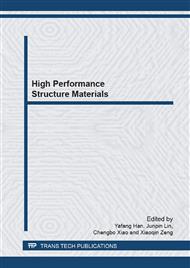p.804
p.810
p.818
p.823
p.828
p.833
p.839
p.844
p.850
Quantification and Statistical Analysis of Microstructural Features in As-Cast Ti-6Al-4V Titanium Alloy
Abstract:
Based on microstructure of as-cast Ti-6Al-4V titanium alloy, an image processing to simplify model of β grain size, α lamella space was developed and a quantitative statistical method of β grain size, α lamella space in two-phase titanium alloys was established, with which β grain size and α lamella space of as-cast Ti-6Al-4V titanium alloy with different plate thickness were analyzed. The relationship between β grain size, α lamellar space and cast plate thickness was discussed. The results show that β grain size and α lamellae thickness nearly linearly increase as plate thickness increasing. β grain size has normal distribution and with cast plate thickness increasing, the dispersion gets larger.
Info:
Periodical:
Pages:
828-832
Citation:
Online since:
February 2013
Authors:
Price:
Сopyright:
© 2013 Trans Tech Publications Ltd. All Rights Reserved
Share:
Citation:


